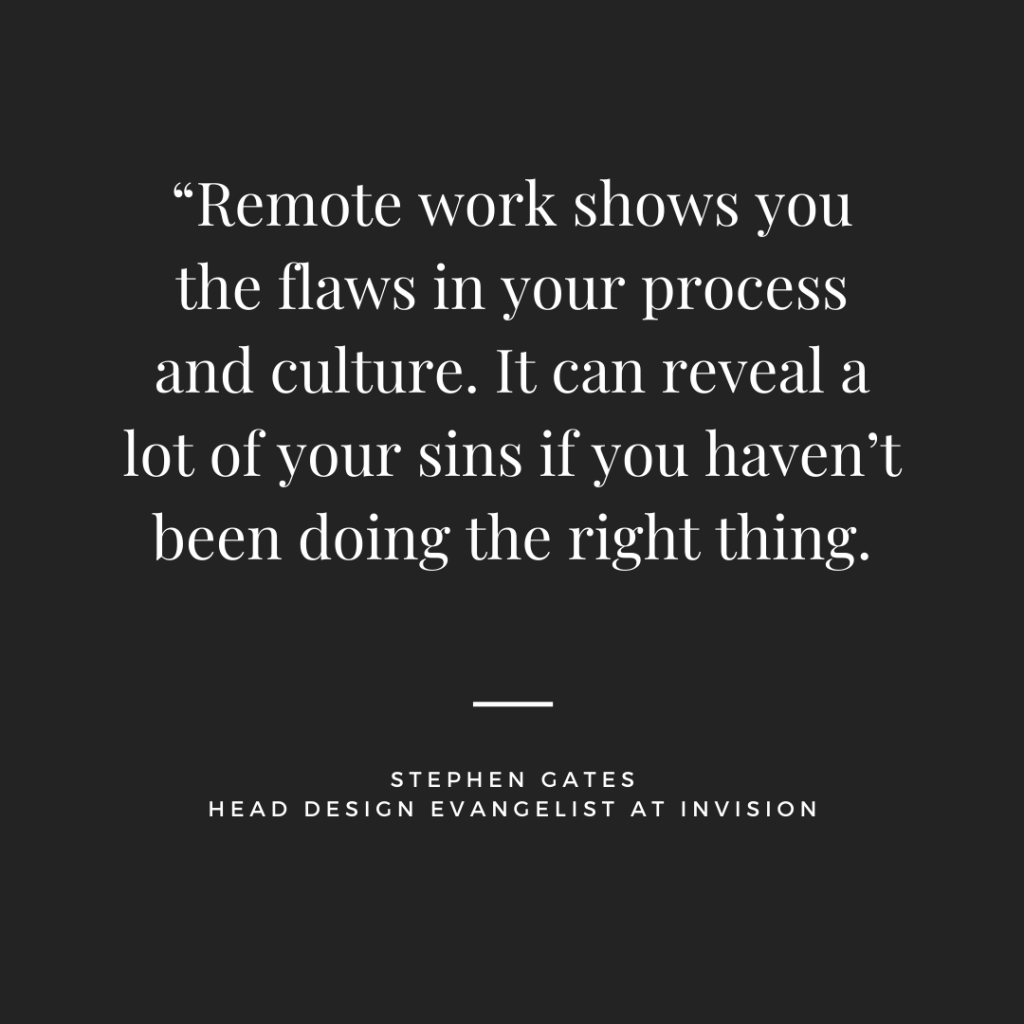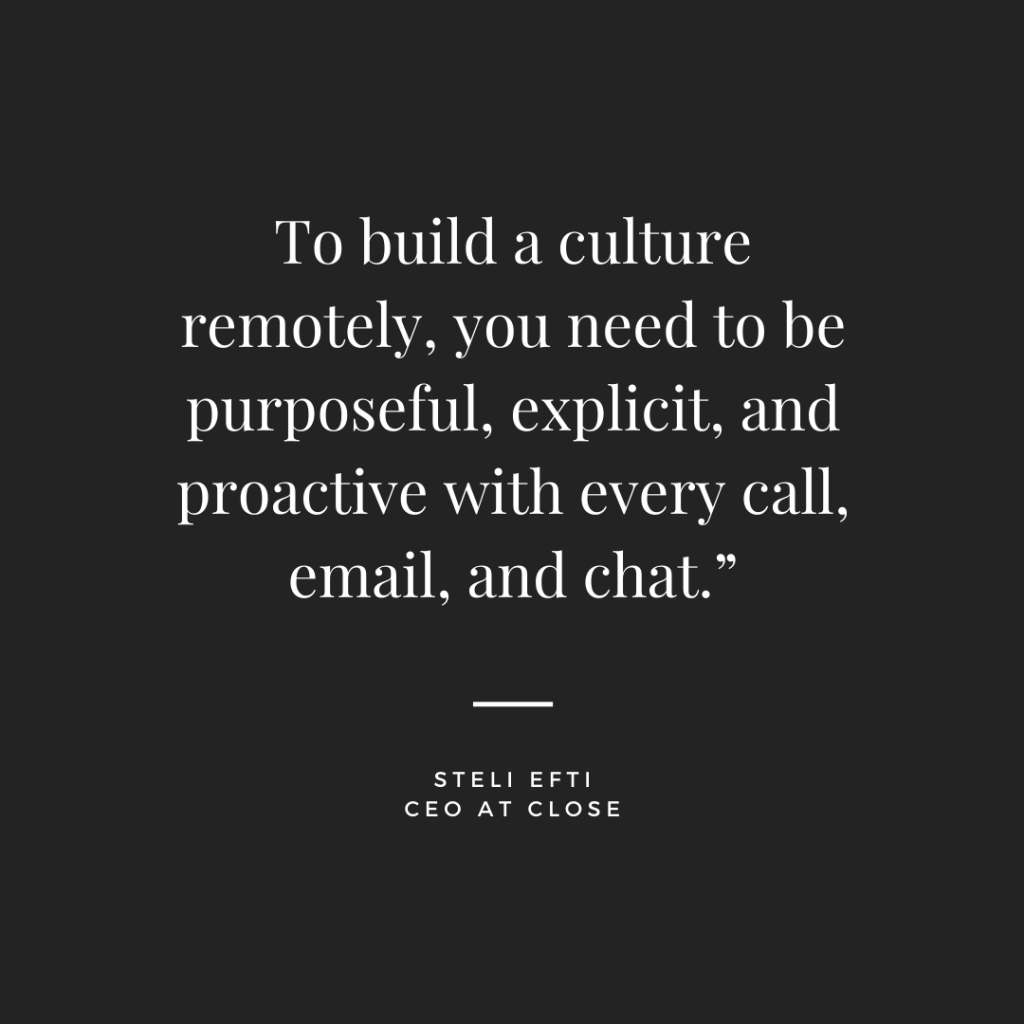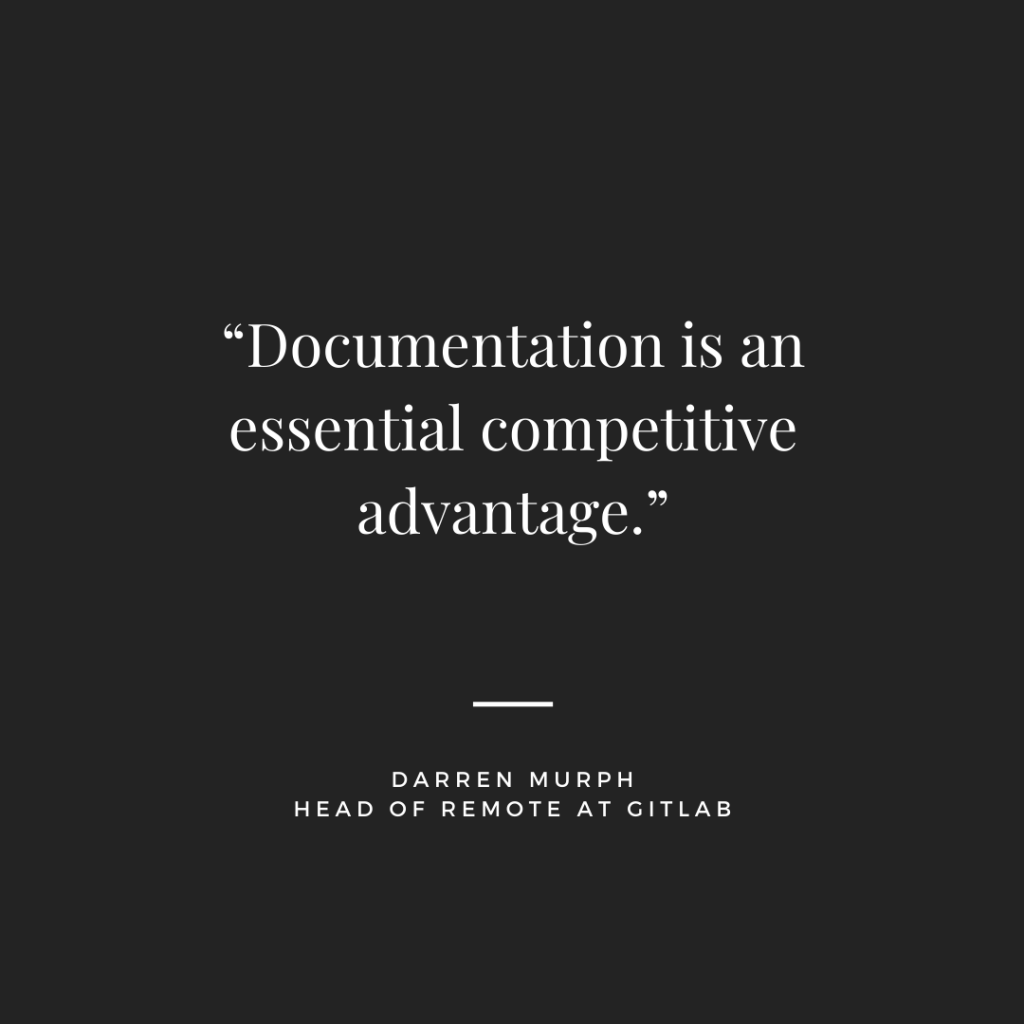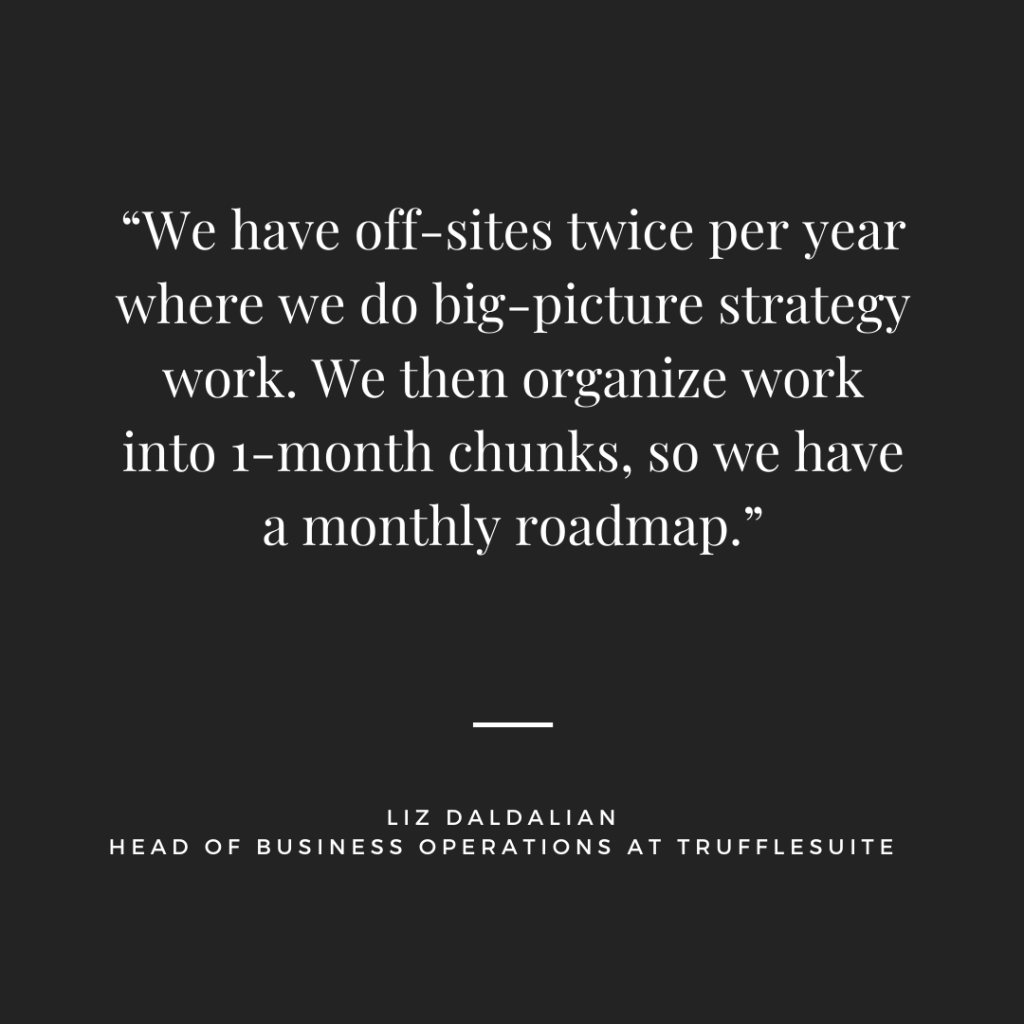Want to become a better leader in 2 minutes a day? Try Bunch: the AI leadership coach for the iPhone. Your first 3-months are on us!
Playing the long game
Nearly two months into lockdown, leaders around the world are rightly wondering what’s next. For all the talk of “the new normal”, we’re all still trying to define what that means for us and our teams.
With politicians debating timelines for “re-starting” the economy, many companies that have the luxury of being able to run remotely are starting to ask: what if we don’t go back to the office at all?
Back in March, we published Going remote, overnight: A practical guide to help your team work from home. It came as most companies in tech were gearing up for their first week ever of all-remote work. It was our most popular blog post ever, for good reason: most of us were feeling unsure of whether we could really make remote work, work.
But now, many teams are embracing it or even enjoying it. Youngme Moon (author of the boook Different) captured this sentiment perfectly on a recent episode of HBR’s After Hours podcast, proclaiming: “You’ll never see me in the office again”.
Leaders are seeing opportunity and wondering why they’re paying for an expensive office and limiting their talent pool to people who live near it. But they’re also realizing that remote work requires attention to some of the details in terms of how work is done and how a culture is built.
“Remote work shows you the flaws in your process and culture,” says Stephen Gates, head design evangelist at InVision, “It can reveal a lot of your sins if you haven’t been doing the right thing.

InVision is a company of 700+ remote-workers, and their leaders know that technology, collaboration tools, and fancy standing-desks are just one part of remote-first work. To succeed in the long-term, we’ll need to thoughtfully design our processes, structures, norms and rituals.
Wade Foster, CEO and Co-founder of Zapier, says “We’ve found there are three important ingredients to making remote work successful: team, tools, and process.”
If you’re thinking about making this remote thing a bit more permanent, this guide should help you sketch out your own game plan for how to approach it based on the learnings from other leaders who’ve done it – or are doing it – too.
5 steps to going remote, permanently:
- Make the decision together
- Codify your culture and make it visible
- Create a system for information flow
- Define the role and rituals for in-person events
- Onboarding new remote team members
Step 1: Make the decision together
You might already feel strongly that remote-first is the right path forward for your company. But even if going remote has worked surprisingly well for your team, it’s important to keep in mind that some people on your probably much prefer the feeling the feeling of going to the office in the morning, and hate rolling out of bed and straight to their laptop.
To be successful long term, you’ll need to consider the different needs and preferences of your team members. Some might need a home office upgrade to do that. Others might need access to a co-working space to be around other people. To get team buy-in, you’ll need to engage everyone in the process and get a little creative.
Anthony Reo, Bunch Co-Founder and COO recently did this with our own team:”We ended up designing 3 different remote work packages to support the team and help each person be successful with remote work in the long term.”
Each package addresses needs and concerns of different team members: from those who need a home office upgrade to make it work, to those who need a co-working membership to get out of the house, to those who need something in-between.
So how can you approach this process? In his 2010 book “Consensus-Oriented Decision-Making”, Psychologist Dr. Tim Hartnett proposes a simple way to engage the team, get buy-in, and make the final decision together:
Team Decision-Making
🖼️First, frame the problem and open discussion
Invite the team to an open discussion, and explain that the company is considering going remote long-term. For context, lay out the benefits and factors you’re considering right now. Ask the team what they’ve enjoyed about working remotely so far, and what’s been difficult.
🤔 Identify underlying concerns
Don’t brush over the concerns raised. Instead, dig deeper on them: what specifically don’t people like about remote work? What do they think the risks are of doing it long term? What makes then nervous? Instead of shutting those concerns down, brainstorm ideas together by asking the group for ideas on how to overcome those obstacles.
🤝 Then, design solutions that work for your team
Now that you’ve got a clear idea of what the challenges are for the team, and a whole bunch of ideas, it’s time to get creative to design flexible solutions to the most common problems. Depending on team size, it makes sense to draft this by yourself or work in a small group.
Look for clusters of problems that you can use to create a few benefits packages to help the majority of your team thrive while working remotely.
A common issue might be with the home office setup. People might need equipment like better desks, chairs, or headphones. Maybe they need an upgraded internet package so Zoom doesn’t freeze up on them all the time.
For others, it’s about overcoming the feeling of being cooped up in the house away from people. These folks might need a co-working membership so they can still get out of the house and enjoy the “hum” of an office (post-lockdown, of course). Or they might need help with work-life boundaries and opportunities to find balance.
✅ Ask for feedback on your solutions
Once you’ve got some more thought-out solution ideas to help everyone transition to remote work longer term, share a draft with the team and ask for feedback before making it official. Incorporate suggestions if you can, but even if you can’t, it means a lot for people to be heard.
🙌 Finally, confirm and communicate your decision
After a round of revisions, it’s time for the big announcement: set up an all-hands call and announce the final decision to go remote. Share your solutions for overcoming problems that were raised, and make sure to celebrate with some remote social time!
Step 2: Codify your culture and make it visible
When you work in the same office together, the culture of the company is all around you. There are cues from the way people talk, the way things look, and what’s going on around you.
The same is true for remote teams, but somehow that culture can be less visible, or it can look different to each team member based on which Slack channels they use most.
Nobody sums this up more aptly than Steli Efti from Close, he says “When you share an office, it’s easy to communicate with people, even non-verbally,” and that establishing a culture remotely is harder because “you don’t see any of that non-verbal communication. That’s why you need to be purposeful, explicit, and proactive with every call, email, and chat.”

So if you’re going remote for good, it makes sense to be even more intentional about the culture you want to build. That starts with defining the ideal culture as a team, then making it visible.
One helpful exercise you can use to do this is The Culture Press Release – based on the legendary Amazon ‘Internal Press Release’ for new products. This will get everyone on the same page about what you’re trying to build, and serve as a useful reference document you can come back to over and over again.
The Culture Press Release
Imagine FastCompany is going to write a profile about your company culture in 2 years. What do you want it to say?
🙋♀️ Let every team member give input
You can choose to have people submit ideas as bullet points or write their own full press release (takes 1-2 hours). This is a great way to collect input from the team and get everyone thinking about culture more seriously.
📝 Write your narrative
After collecting ideas from the team, write your own final version of the press release. You can use this format:
- Heading — What is the title or headline of the article?
- Sub-Heading — One sentence underneath the title. Describe what makes your culture unique in 1 sentence.
- Summary — Give a one-paragraph summary of the problems that hold companies back, and how your culture helped you overcome or avoid them.
- Problem — Describe the problems your culture is designed to solve or prevent in more detail.
- Solution — Describe your ideal culture in more detail. What are the core values you live by, and how?
- Quote from You — A quote from a spokesperson in your company.
- How to Get Started — Describe how you got started (this will likely be your first step in real life!)
- Employee Quote — Provide a quote from a hypothetical employee that describes how they experienced the benefit from the culture.
- Closing and Call to Action — Wrap it up and imagine what pointers the journalist might give to the reader. What should they do next? (Hint: it might be to apply at your company!)
This final version should be inspired by the team’s input, but don’t try to “Frankenstein” every idea into the story. You’ll need to make decisions on what to include and what to leave out.
🎨 Visualize the result
Try creating a visual asset to summarize the content of your press release. It should be something you can refer to in hiring, performance reviews, 1:1s, and team rituals. Here are some ideas:
- A presentation deck
- A behaviors checklist
- A desktop background image
- A Zoom virtual background
- Send out posters to team members
This should help keep the culture top of mind!
Step 3: Create a system for information flow
Long-term communication requires thought, process, and best-practice.
GitLab has the snazzy title of the world’s largest remote company and Head of Remote Darren Murph says when it comes to communication “documentation is an essential competitive advantage.”

Long-term communication strategies should reinforce accountability and collaboration, and make life easier for team members. Choosing your communication tools is just one step – they won’t do the work for you.
Companies like GitLab lean on rituals to make that documentation a part of the daily habit. Here are a a few you can try.
Remote Rituals for Information Flow
👐 Daily Handovers
When you have frequent collaboration between teams (from design to development, for example) it can be hard to avoid information silos. Try creating a daily handover channel on Slack or have a virtual space where each person or team can document what was achieved that day and who can take over/when. The wider team is more likely to read this than follow closely in your project management tool (though keep using that too!). The magic in this one is repetition: keep it up every day for a week or two and it will become habit.
📤 Share weekly learnings
Schedule a recurring meeting on Fridays for the whole team to take turns sharing key learnings from the week, or if you prefer, dedicate time for them to write down their learnings each week for the rest of the team. A shared Google Doc will help everyone maintain. a big picture view of what’s going on across the business.
📈 Shared 1-on-1 time
Creating a ritual for informal information flow can make a big difference too! Having “randomized” 1:1 coffee meetings are with a relatively open agenda Send out a calendar invite to block everyone’s calendar for the same hour, and dedicate the time to having team 1:1s. Ask everyone to meet with a different colleague each week to catch up, share what they’re working on, and get to know each other better.
Step 4: Define the role and rituals for in-person events
Even for an all-remote team, there might be a role for some in-person events in your team – either for bonding and social opportunities, or for collaboration on big-picture strategy that requires a switch in mindset.
Liz Daladian, Head of Business Operations & Delivery at Truffle Suite (a remote-first company), says: “We have off-sites twice per year where we do a lot of our big-picture strategy work: planning, roadmaps, the state of business, financials, policies, etc. We then organize work into 1-month chunks, so we have a monthly roadmap.”

Offsite meetings are an opportunity to bring people together to make decisions so you can go back to the ‘office’ the next day and start taking action. Think first about what an offsite means to you – it may be all about fun, or it might be all about productivity.
It will take some time to find the right agenda and cadence for you, but we all have to start somewhere, so here are a few tips to have productive in-person events like Truffle does:
🏞️ Define purpose and goals
The frequency and agenda of in-person events will depend a lot on what you hope to get out of them. It’s easy to make a list, but stay focused, a good question to ask yourself: what is the #1 benefit to getting everyone together in person?Plan everything around realizing this benefit.
📅 Create an agenda
If your event is primarily for team-building, you might organize lots of ‘icebreaker’ activities to get people mingling. If it’s primarily collaboration, you might try a ‘hackathon’ instead with cross-functional teams. What’s most important is designing the schedule around the benefit you’re hoping to gain. Things always take longer than you expect, so keep it to 3-4 main activity blocks per day. It’s usually best to get feedback on a draft version before committing to it.
🧑💻 Decide how to measure success
No matter what your goals are, you’ll need to know if you’ve achieved them or not. For example, Liz’s team at Truffle Suite aims to come out of every offsite with a clear, updated roadmap. A good roadmap largely means a successful offsite. If your offsite is mainly for social purposes, think about how you can measure how successful it was.
🗓️Create a ‘How-we offsite’ document
As you prepare for your first offsite, write up all of the above: what it is, why you have one, who attends, what happens there, what people will learn, etc. After your first event, write down your learnings, and your hypothesis for how often you should run these (ideally informed by feedback from the team), where it should be, what time of year, etc.
Step 5: Onboarding new remote team members
Right now, recruitment might not be at the forefront of your mind. If you are pivoting to a long-term remote situation, it’s important to nail onboarding for it is a crucial embedding opportunity.
Onboarding is a crucial step in getting a new team member up to speed. The GitLab manual says “Onboarding remotely should focus on three key dimensions: the organizational, the technical, and the social.”
Perhaps the biggest challenge for onboarding remote team members is getting them up to speed culturally. How do you enable them to quickly become a part of that culture instead of feeling like. an observer? Cultural Onboarding can make a world of difference.
Cultural Onboarding
📅 Make it a part of day 1
Schedule a Zoom-based cultural onboarding session with every new team member on their first day. The goal should be to get them up to speed on how your team works, and what you expect from each other. Ideally, you have a written document already that conveys the values of your team – but if you don’t, explaining them verbally will do.
🧑🏫 Give lots of examples
For each of your team’s values, give your new team member several positive and challenging examples. This way they’ll gain a better sense of what behavior is needed in different situations.
💭 Reflect, together
In this session, you’re not looking for your team member to simply download information. They need to reflect on the principles, and you can help them do that by asking questions and sharing advice.
Ask them: What’s exciting about the culture? What’s scary? Finally, reassure them that some of the norms can be hard to live up to – even founders struggle at times!
You’ve got this!
As with anything, your remote work strategy and processes will take a bit of experimentation and learning , but by being proactive about these 5 steps, you’ll put yourself on a path to long term success as a remote-first company.
#RemoteNotDistant
Want to become a better leader in 2 minutes a day? Try Bunch: the AI leadership coach for the iPhone. Your first 3-months are on us!





